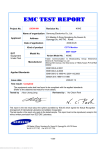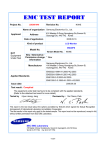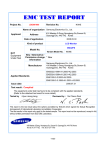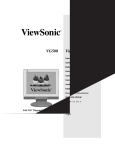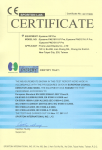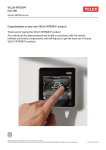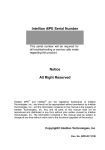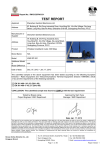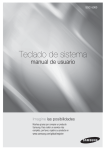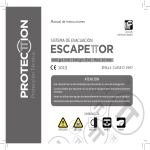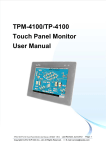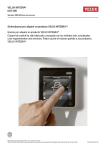Download EMC TEST REPORT - ADI Global Distribution
Transcript
EMC TEST REPORT Project No. LBE081274 Revision No. NONE Name of organization Samsung Electronics Co., Ltd. Applicant Address 416 Maetan 3-Dong,Yeongtong-Gu,Suwon-Si, Gyeonggi-Do, 443-742 Korea Date of application 2008.04.11 Kind of product EUT Equipment Under Test Model No. Manufacturer Applied Standards SYSTEM Keyboard SSC-5000 Variant Model No. None KEVIS Inc #803, 104 SK Ventium, 522, Dangjeong-Dong, Gunpo-Si, Gyunggi-Do, Korea 435-776 EN61000-6-4:2001 EN61000-3-2:2000+A2:2005 EN61000-3-3:1995+A2:2005 EN50130-4:1995+A2:2003 Test Period 2008-04-15 ~ 19 Issue date 2007.04.22 Test result : Complied The equipment under test has found to be compliant with the applied standards. (Refer to the attached test result for more detail.) Tested by : Tae Young, Jang Reviewed by : No Cheon, Park This report is the test result about the sphere accredited by KOLAS which signed the Mutual Recognition Arrangement of International Laboratory Accreditation Cooperation. The test results in this report only apply to the tested sample. This report must not be reproduced, except in full, without written permission from SEC EMC Laboratory. SEC EMC Laboratory 416 Maetan 3-Dong, Yeongtong-Gu, Suwon-Si, Gyeonggi-Do, 443-742 Korea Tel: 82 31 277 7752, Fax: 82 31 277 7753 -1/45- Project No. : LBE081274 System Keyboard SSC-5000 Table of contents 1. Summary of test results 1.1 Emission 1.2 Immunity 2. General Information 2.1 Test facility 2.2 Accreditation and listing 2.3 EUT Description 3. Test configuration 3.1 Test Peripherals 3.2 EUT operating mode 3.3 Details of Sampling 3.4 Used cable description 3.5 EUT Description 3.6 Performance Criteria 3.7 Measurement uncertainty 4. Result of individual tests 4.1 Conducted disturbance 4.2 Radiated disturbance 4.3 Harmonics current 4.4 Voltage fluctuation & Flicker 4.5 Electrostatic discharge 4.6 Radiated, radio-frequency, electromagnetic field 4.7 Electrical fast transient/burst 4.8 Surge 4.9 Conducted disturbances, induced by radio-frequency fields 4.10 Voltage dips, short interruptions and voltage variations Appendix – EUT photography -2/45This report must not be reproduced, except in full, without written permission from SEC EMC Laboratory. Project No. : LBE081274 System Keyboard SSC-5000 1. Summary of test results 1.1 Emission The EUT has been tested according to the following specifications: Applied Test type Applied standard Conducted Disturbance (Mains Port) Result Remarks Complied Minimum margin is 36.3 dB at 0.162 MHz Complied Minimum margin is 5.2 dB at 497.859 MHz EN61000-6-4:2001 Radiated Disturbance Harmonics current EN61000-3-2:2000 N/A Voltage fluctuation & Flicker EN61000-3-3:1995+ A1:2001 Complied The power of EUT is below 75W Meets the Requirements 1.2 Immunity The EUT has been tested according to the following specifications: Applied Performance Criterion Test type Applied standard Electrostatic discharge EN61000-4-2:1995 A B C B Radiated, radio-frequency, electromagnetic field EN61000-4-3:1995 A B C C Electrical fast transient/burst EN61000-4-4:1995 A B C B Surge EN61000-4-5:1995 A B C B Radio-frequency conducted EN61000-4-6:1996 A B C C A B C A B C A B C A B C Voltage dips, short interruptions and voltage variations Power-frequency magnetic field EN61000-4-11:1994 EN61000-4-8:1993 Result Specification B : 30%,60%, 100%Reduction A : Voltage 10% Up Voltage 15% Down A -3/45This report must not be reproduced, except in full, without written permission from SEC EMC Laboratory. Project No. : LBE081274 System Keyboard SSC-5000 2. General Information 2.1 Test facility The SEC EMC Laboratory is located on Samsung Electronics Co., Ltd. at 416 Maetan 3-Dong, Yeongtong-Gu, Suwon-Si, Gyeonggi-Do, South Korea. All testing are performed in Semi-anechoic chambers conforming to the site attenuation Characteristics defined by ANSI C63.4, CISPR 22, 16-1 and 16-2. and Shielded rooms. The SEC EMC Laboratory is operated as testing laboratory in accordance with the requirements of ISO/IEC 17025:2005. 2.2 Accreditation and listing Laboratory Qualifications Remarks KOLAS(Korea Laboratory Accreditation Scheme) Accredited : 124 Radio Research Laboratory Accredited : KR0004 FCC(Federal Communications Commission) Accredited : KR0004 National Voluntary Laboratory Accreditation Program Lab Code: 200623-0 Norges Elektriske Materiellkontroll Accredited : ELA 195 VCCI (Voluntary Control Council for Interference by Information Technology Equipment) C-2421,R-2224 China Quality Certification Center 5-053, 5-054 TUV Rhineland H9354285 GOST(GOSTSTANDART) ROSTEST Elektrotechnicky Zkusebni Ustav Reg. No.: 001 IC(Industry Canada) Assigned Code: 5871 -4/45This report must not be reproduced, except in full, without written permission from SEC EMC Laboratory. Project No. : LBE081274 System Keyboard SSC-5000 3. Test Setup configuration 3.1 Test Peripherals The cables used for these peripherals are either permanently attached by the peripheral manufacturer or coupled with an assigned cable as defined below. The following is a listing of the EUT and peripherals utilized during the performance of EMC test: Description Model No. Serial No. Manufacturer Cable Type System Keyboard SCC-5000 - Samsung - AC adapter LSE0107A1230 - LI SHIN - CCTV Camera SCC-C4201 - Samsung - YK-12060K LN22A450 - Samsung - 3.2 EUT operating mode To achieve compliance applied standard specification, the following mode(s) were made during compliance testing: Operating Mode 1 CCTV Controlling 3.3 Details of Sampling Customer selected, single unit. 3.4 Used cable description The EUT is configured, installed, arranged and operated in a manner consistent with typical applications. Interface cables/loads/devices are connected to at least one of each type of interface port of the EUT, and where practical, each cable shall be terminated in a device typical of actual usage. The type(s) of interconnecting cables to be used and the interface port (of the EUT) to which these were connected; No. From the port of EUT To Length[m] NOTE 1 DC in AC adapter 1.5 No 2 Video out TV Monitor 1.0 No 3 RS-485 CCTV Camera 1.5 No -5/45This report must not be reproduced, except in full, without written permission from SEC EMC Laboratory. Project No. : LBE081274 System Keyboard SSC-5000 3.5 EUT Description The following features describe EUT represented by this report: Model Name SSC-5000 CONNECTOR TYPE : 8P TERMINAL TYPE INTERFACE(RS-485) PORT : 2 PORT BAUD RATE : 1200 / 2400 / 4800 / 9600 / 19200 / 38400 bps 4.3" TFT LCD PANEL + TOUCH PANEL TFT LCD PANEL EFFECTIVE DISPLAY AREA : 95.040mm[H] x 53.856mm[V] NUMBER OF DOTS : 1440[H] x 272[V] DOT PITCH : 66.0 ㎛[H] x 198.0 ㎛[V] USB PORT (USB 2.0) S/W Upgrade VIDEO INPUT/OUTPUT Composite Video 1.0Vp-p, 75ohm, BNC Type, Loop Through out OSD Cze/Tur/Chi/Jpa/Bra(Port)/Neth/Denma/Croatia) Pelco-D, Pelco-P, Vicon, Panasonic, GE-Khalatel, Diamond, MULTI PROTOCOL(CAMERA) American Dynamic,Philips,Erna,VCLTP,Samsung Electronics ,Honeywell,Techwin JOY STICK 3D JOY STICK (PAN/TILT/ZOOM) LED MONITOR, CAMERA, DVR PAN : LEFT / RIGHT TILT : UP / DOWN IRIS : CLOSE / OPEN PAN/TILT & LENS CONTROL FOCUS : FAR / NEAR ZOOM : TELE / WIDE PRESET, PATTERN, AUTO PAN, SCAN AUX1, AUX2, AUX3, AUX4 Target : SAMSUNG DVR DVR CONTROL SW : RW, STOP, PLAY, FF, REC JOG/SHUTTLE : FORWARD/REVERSE, PLAY/REVERSE PLAY/FF/RW POWER DC 12V POWER CONSUMPTION 4W OPERATION TERPERATURE 0℃ ~ 40℃ OPERATION HUMIDITY RANGE 0 ~ 90% DIMENSIONS(WxHxD) 496 x 197 x 282 -6/45This report must not be reproduced, except in full, without written permission from SEC EMC Laboratory. Project No. : LBE081274 System Keyboard SSC-5000 3.6 Performance Criteria Performance criterion A The equipment shall continue to operate as intended without operator intervention. No degradation of performance or loss of function is allowed below a performance level specified by the manufacturer when the equipment is used as intended. The performance level may be replaced by a permissible loss of performance. If the minimum performance level or the permissible performance loss is not specified by the manufacturer, then either of these may be derived from the product description and documentation, and by what the user may reasonably expect from the equipment if used as intended. Performance criterion B After the test, the equipment shall continue to operate as intended without operator intervention. No degradation of performance or loss of function is allowed, after the application of the phenomena below a performance level specified by the manufacturer, when the equipment is used as intended. The performance level may be replaced by a permissible loss of performance. During the test, degradation of performance is allowed. However, no change of operating state or stored data is allowed to persist after the test. If the minimum performance level (or the permissible performance loss) is not specified by the manufacturer, then either of these may be derived from the product description and documentation, and by what the user may reasonably expect from the equipment if used as intended. Performance criterion C Loss of function is allowed, provided the function is self-recoverable, or can be restored by the operation of the controls by the user in accordance with the manufacturer’s instructions. Functions, and/or information stored in non-volatile memory, or protected by a battery backup, shall not be lost. 3.7 Measurement uncertainty Where relevant, the following measurement uncertainty levels have been estimated for tests performed on the apparatus: (According to CISPR 16-4 and UKAS Lab 34.) 3.7.1 Emission Measurement uncertainty (C.L. 95 %, k = 2) Test type Conducted disturbance Radiated Disturbance ± 2.8 dB ± 4.82 dB ± 4.82 dB ± 5.42 dB ± 5.42 dB -7/45This report must not be reproduced, except in full, without written permission from SEC EMC Laboratory. Project No. : LBE081274 System Keyboard SSC-5000 4. Results of individual test 4.1 Conducted disturbance Both conducted lines are measured in Quasi-Peak and Average mode, including the worst-case data points for each tested configuration. The EUT measured in accordance with the methods described in Clause 9. Limits for conducted disturbance at the mains ports of class A ITE NOTE Limits dB(μV) Frequency range Limits MHz Quasi-peak Average 0,15 to 0,50 79 66 0,50 to 30 73 60 The lower limit shall apply at the transition frequency Limits for conducted disturbance at the mains ports of class B ITE Limits dB(μV) Frequency range Limits MHz Quasi-peak Average 0,15 to 0,50 66 to 56 56 to 46 0,50 to 5 56 46 5 to 30 60 50 NOTE 1 The lower limit shall apply at the transition frequency NOTE 2 The limit decreases linearly with the logarithm of the frequency in the range 0,15 MHz to 0,50 MHz. 4.1.1 Test instrumentation Test instrumentation used in the Conducted disturbance test was as follows: Test instrumentation Model name Manufacturer Serial or Firmware (No./Ver.) Calibration Interval Date (Month) Field Strength meter ESCI R&S 100368 2007-06-01 12 L.I.S.N (For EUT) ENV216 R&S 100116 2007-09-13 12 Test Software EMC32 R&S Ver 5.20.2 N/A N/A -8/45This report must not be reproduced, except in full, without written permission from SEC EMC Laboratory. Project No. : LBE081274 System Keyboard SSC-5000 4.1.2 Photograph of the test Configuration (Front) (Rear) -9/45This report must not be reproduced, except in full, without written permission from SEC EMC Laboratory. Project No. : LBE081274 System Keyboard SSC-5000 4.1.3 Test results CCTV Controlling Operating condition 2008-04-18 Test date Climate condition Ambient temperature Tae Young, Jang Test engineer 22.3 ℃ Relative humidity Atmospheric Pressure 33 % 101.5 KPa Shielded Room #1 Test place * QP : Quasi-peak, AV: Average * Result = Level(QP or AV) + Corr. (LISN Insertion loss + Cable loss – Amplifier Gain) * Margin = Limit - Level Note Hardware Setup: Voltage with ENV 2-Line-LISN - [EMI conducted] Subrange 1 Frequency Range: Receiver: Transducer: 150kHz - 30MHz ESCI 3 ENV216 / Receiver-2-Line-LISN ENV216 Scan Setup: EN55022_A_ENV 2-Line-LISN fin [EMI conducted] Hardware Setup: Level Unit: Voltage with ENV 2-Line-LISN dBμV Subrange 150kHz - 30MHz Detectors QuasiPeak; Average IF Bandwidth 9kHz EN55022_A with ENV 2-Line-LISN Meas. Time 5s Receiver ESCI 3 100 90 80 EN 55022_A Voltage on Mains QP Level in dBμV 70 EN 55022_A Voltage on Mains AV 60 50 40 30 20 10 0 150k 300 400 500 800 1M 2M 3M 4M 5M 6 8 10M 20M 30M Frequency in Hz -10/45This report must not be reproduced, except in full, without written permission from SEC EMC Laboratory. Project No. : LBE081274 System Keyboard SSC-5000 Final Measurement Detector 1 Frequency (MHz) 0.161 500 0.189 500 0.219 500 0.643 500 10.178 500 10.513 500 QuasiPeak (dBμV) Line 41.1 38.0 34.2 27.8 26.7 24.8 Corr. (dB) L1 L1 L1 L1 L1 L1 Margin (dB) 9.6 9.6 9.6 9.7 9.9 9.9 Limit (dBμV) 37.9 41.0 44.8 45.2 46.3 48.2 79.0 79.0 79.0 73.0 73.0 73.0 Final Measurement Detector 2 Frequency (MHz) Average (dBμV) Line Corr. (dB) Margin (dB) Limit (dBμV) 0.162 500 29.7 N 9.6 36.3 66.0 0.568 500 21.6 N 9.6 38.4 60.0 0.647 500 23.3 N 9.6 36.7 60.0 10.191 500 21.2 L1 9.9 38.8 60.0 10.653 500 21.0 N 9.9 39.0 60.0 19.710 500 21.8 N 10.2 38.2 60.0 -11/45This report must not be reproduced, except in full, without written permission from SEC EMC Laboratory. Project No. : LBE081274 System Keyboard SSC-5000 4.2 Radiated disturbance Of those disturbances above (L - 20dB), where L is the limit level in logarithmic units, record at least the disturbance levels and the frequencies of the six highest disturbances. The following data lists the significant emission frequencies, measured levels, correction factors (for antenna and cables), orientation of table, polarization and height of antenna, the corrected reading, the limit, and the amount of margin. All measurements were taken utilizing quasi-peak detection unless stated otherwise. Measurements were performed at an antenna to EUT distance of 10 meters and elevated between 1 and 4 meters. Both vertical and horizontal antenna polarizations were measured. Limits for radiated disturbance of ITE at a measuring distance of 10 m Quasi-peak Limits dB dB(μV/m) Frequency range Limits MHz Class A Class B 30 to 230 40 30 230 to 30 47 37 NOTE 1 The lower limit shall apply at the transition frequency NOTE 2 Additional provisions may be required for cases where interference occurs. 4.2.1 Test instrumentation Test instrumentation used in the Radiated disturbance was as follows: Test instrumentation Model name Serial or Firmware (No./Ver.) Manufacturer Calibration Date Interval (Month) EMI Test Receiver ESI-26 R&S 836092/002 2008-03-18 12 EMI Test Receiver ESI-26 R&S 100147 2007-06-15 12 Ant. Mast MA4000 inn-co - N/A N/A Ant. Mast MA4000 inn-co - N/A N/A Mast Controller CO2000 inn-co - N/A N/A Mast Controller CO2000 inn-co - N/A N/A Amplifier 310N SONOMA 251674 2008-03-13 12 Amplifier 310N SONOMA 186467 2008-04-01 12 RF selector NS4900 TOYO - N/A N/A Bi-log Antenna CBL6112D SCHAFFNER 22603 2007-04-02 24 Bi-log Antenna CBL6112D SCHAFFNER 22604 2006-06-26 24 -12/45This report must not be reproduced, except in full, without written permission from SEC EMC Laboratory. Project No. : LBE081274 System Keyboard SSC-5000 4.2.2 Photograph of the test Configuration (Front) (Rear) -13/45This report must not be reproduced, except in full, without written permission from SEC EMC Laboratory. Project No. : LBE081274 System Keyboard SSC-5000 4.2.3 Test results CCTV Controlling Operating condition 2008-04-15 Test date Ambient temperature Climate condition 22.1℃ Tae Young, Jang Test engineer Relative humidity Atmospheric Pressure 33% 10m Semi-Anechoic Chamber Test place * Test distance : 10 m * Result = Reading + c.f (Antenna factor + Cable loss- Amp Gain) * Margin = Limit – Result Note <<Radiated Emission>> Model : SSC-5000 Serial : Operator : T Y JANG AC Power : Temp,Humidity: [dB(uV/m)] 60 Standard Remark1 Remark2 Remark3 Remark4 15 April,2008 16:28 : CISPR Pub.22 Class A 10m : : : : <10m_CISPRA> Limit <RE> Spectrum(H,PK) Spectrum(V,PK) Suspected Item(H) Suspected Item(V) Final Item(H,QP) Final Item(V,QP) 50 40 Level 100 kPa 30 20 10 0 30 50 100 500 1000 [MHz] Frequency Final Result --- Horizontal Polarization (QP)--No. Frequency Reading c.f Result [MHz] [dB(uV)] [dB(1/m)] [dB(uV/m)] 1 149.338 47.1 -19.0 28.1 2 215.989 49.7 -19.1 30.6 Limit [dB(uV/m)] 40.0 40.0 Margin [dB] 11.9 9.4 Remark --- Vertical Polarization (QP)--No. Frequency Reading c.f Result [MHz] [dB(uV)] [dB(1/m)] [dB(uV/m)] 1 149.355 50.4 -18.5 31.9 2 188.989 51.5 -19.4 32.1 3 193.734 47.0 -19.2 27.8 4 199.156 53.1 -19.0 34.1 5 202.781 42.3 -19.1 23.2 6 497.859 50.7 -8.9 41.8 Limit [dB(uV/m)] 40.0 40.0 40.0 40.0 40.0 47.0 Margin [dB] 8.1 7.9 12.2 5.9 16.8 5.2 Remark -14/45This report must not be reproduced, except in full, without written permission from SEC EMC Laboratory. Project No. : LBE081274 System Keyboard SSC-5000 4.3 Harmonics current The EUT operated to produce the maximum harmonic components under normal operating conditions for each successive harmonic component in turn. The power consumption, steady state harmonic currents were measured in the tested operating mode(s). The EUT measured in accordance with the test conditions described in Annex C (C.10). Limits for Class A equipment Harmonic order Maximum permissible harmonic current n A Odd Harmonics 3 5 7 9 11 13 15≤ n≤ 39 2,30 1,14 0,77 0,40 0,30 0,21 0,15 15/n Even harmonics 2 4 6 8≤ n≤ 40 1,08 0,43 0,30 0,23 8/n 4.3.1 Test instrumentation Test instrumentation used in the Harmonics current test was as follows: Test instrumentation Model name Manufacturer Serial or Firmware (No./Ver.) Power Analyzer PM6000 Voltech 100006700167 2007-10-12 12 IEC Network 555 ZIMMER IB10/9466 N/A N/A Calibration Interval Date (Month) -15/45This report must not be reproduced, except in full, without written permission from SEC EMC Laboratory. Project No. : LBE081274 System Keyboard SSC-5000 4.3.2 Photograph of the test Configuration -16/45This report must not be reproduced, except in full, without written permission from SEC EMC Laboratory. Project No. : LBE081274 System Keyboard SSC-5000 4.3.3 Test results CCTV Controlling Operating condition Test date Climate condition Test place 2008-04-18 Ambient temperature 24.3℃ Test engineer Relative humidity 37% Tae Young, Jang Atmospheric Pressure Shielded Room #3 * This EUT doesn’t need to be tested because the power of EUT is below 75 W. -17/45This report must not be reproduced, except in full, without written permission from SEC EMC Laboratory. 101.4 kPa Project No. : LBE081274 System Keyboard SSC-5000 4.4 Voltage fluctuation & Flicker The EUT operated to produce the most unfavorable sequence of voltage changes under normal operating conditions. During the flicker measurement, the measure time shall include that part of whole operation cycle in which the EUT produce the most unfavorable sequence of voltage changes. Limits of voltage fluctuations and flicker at the supply terminals the relative the value of d(t) during a short-term flicker steady-state voltage voltage change, d(t) indicator, Pst change, dc >3.3 % 1.0 3.3 % the maximum relative voltage change, dmax 500 ms 4% 4.4.1 Test instrumentation Test instrumentation used in the Voltage fluctuation & Flicker test was as follows: Test instrumentation Model name Manufacturer Serial or Firmware (No./Ver.) Power Analyzer PM6000 Voltech IEC Network 555 ZIMMER Calibration Date Interval (Month) 10000670016 7 2007-10-12 12 IB10/9466 N/A N/A 4.4.2 Photograph of the test Configuration Is Same the Harmonic current test photograph. -18/45This report must not be reproduced, except in full, without written permission from SEC EMC Laboratory. Project No. : LBE081274 System Keyboard SSC-5000 4.4.3 Test results CCTV Controlling Operating condition Test date Climate condition Test place 2008-04-18 Ambient temperature 24.3℃ Test engineer Relative humidity 37% Tae Young, Jang Atmospheric Pressure Shielded Room #3 -19/45This report must not be reproduced, except in full, without written permission from SEC EMC Laboratory. 101.4 kPa Project No. : LBE081274 System Keyboard SSC-5000 4.5 Electrostatic discharge Contact discharges to the conductive surfaces and coupling planes: The EUT shall be exposed to at least 200 discharges, 100 each at negative and positive polarity, at a minimum of four test points. One of the test points are subjected to at least 50 indirect discharges to the center of the front edge of the horizontal coupling plane. The remaining three test points are each receive at least 50 direct contact discharges. If no direct contact test points are available, then at least 200 indirect discharges be applied in the indirect mode. Test is performed at a maximum repetition rate of one discharge per second. Air discharges at slots and apertures and insulating surfaces: On those parts of the EUT where it is not possible to perform contact discharge testing, the equipment should be investigated to identify user accessible points where breakdown may occur. Such points are tested using the air discharge method. This investigation should be restricted to those area normally handled by the user. A minimum of 10 single air discharges shall be applied to the selected test point for each such area. The EUT was tested with all I/O ports exercised. Test results are listed below. The basic test procedure was in accordance with IEC 61000-4-2. Performance criteria Application of discharge Test specification (kV) Performance criteria Contact discharge 6 B Air Discharge 8 B 4.5.1 Test instrumentation Test instrumentation used in the Electrostatic discharge test was as follows: Test instrumentation ESD Gun Vertical Plane Model name NSG435 VCP-1 Manufacturer Schaffner Thermo Keytek Serial or Firmware (No./Ver.) 001506 - Calibration Date 2008-03-27 - Interval (Month) 12 - -20/45This report must not be reproduced, except in full, without written permission from SEC EMC Laboratory. Project No. : LBE081274 System Keyboard SSC-5000 4.5.2 Photograph of the test Configuration -21/45This report must not be reproduced, except in full, without written permission from SEC EMC Laboratory. Project No. : LBE081274 System Keyboard SSC-5000 4.5.3 Test results CCTV Controlling Operating condition 2008-04-18 Test date Climate condition Ambient temperature Tae Young, Jang Test engineer 24.3℃ Relative humidity Atmospheric Pressure 37% 101.4 KPa Shielded Room #3 Test place Test Method No Indirect - Direct Applied Point Discharge Method Test Level(KV) Observation [Note No.] Test Result HCP Contact ±2 ±4 ±6 Note 1 2 A B C VCP Contact ±2 ±4 ±6 Note 1 2 A B C 1 LCD Air ±2 ±4 ±8 Note 1 2 A B C Direct 2 Button Air ±2 ±4 ±8 Note 1 2 A B C Direct 3 Jog Shuttle Air ±2 ±4 ±8 Note 1 2 A B C Direct 4 Joy-stick Air ±2 ±4 ±8 Note 1 2 A B C Direct 5 DC IN Air ±2 ±4 ±8 Note 1 2 A B C Direct 6 RS-485 Air ±2 ±4 ±8 Note 1 2 A B C Direct 7 Video In/Out Air ±2 ±4 ±8 Note 1 2 A B C NOTE 1. There was no change compared with initial operation during the test. 2. While the electrostatic discharge tests, malfunction appeared in normal operate, but self-recoverable after the test. -22/45This report must not be reproduced, except in full, without written permission from SEC EMC Laboratory. Project No. : LBE081274 System Keyboard SSC-5000 4.5.4 Tested points ■ Air discharge points ■ Contact discharge points ■ Air/Contact discharge points ■ Front 1 4 3 2 ■ Rear 5 6 7 -23/45This report must not be reproduced, except in full, without written permission from SEC EMC Laboratory. Project No. : LBE081274 System Keyboard SSC-5000 4.6 Radiated, radio-frequency, electromagnetic field The test was performed with the EUT exposed to both vertically and horizontally polarized fields. on each of the four sides. The dwell time at each frequency shall be not less than the time necessary for the EUT to be able to respond. The basic test procedure was in accordance with IEC 61000-4-3. Performance criteria Test range [MHz] Test specification 80~2000 10V/m 80% AM (1KHz) 10V/m 80% PM (1KHz) 3V/m 80% AM (1KHz) 3V/m 80% PM (1KHz) 1V/m 80% AM (1KHz) 1V/m 80% PM (1KHz) Performance criteria Remarks The test level specified is prior to modulation The test level specified is prior to modulation The test level specified is prior to modulation C B A 4.6.1 Test conditions Test condition in the Radiated, radio-frequency, and electromagnetic field test was as follows: 1. Representative operating conditions of EUT Table-top 2. Type of the EUT Floor-standing 3. Type of test facility 4. Position of the radiating antennas 5. Type of antennas 6. Frequency sweep rate 7. Dwell time and frequency steps 8. Applied test level CCTV Controlling a combination of the two a height above the ground plane; 0.1 m 0.8 m 3m Fully anechoic chamber a distance of 3 meters from the EUT Log-periodic 1.5 x 10-3 decades/s Dwell time : 3 s, Step size : 1 % 1V/m, 3V/m, 10V/m -24/45This report must not be reproduced, except in full, without written permission from SEC EMC Laboratory. Project No. : LBE081274 System Keyboard SSC-5000 4.6.2 Test instrumentation Test instrumentation used in the Radiated, radio-frequency, and electromagnetic field test was as follows: Serial or Calibration Test instrumentation Model name Manufacturer Firmware date Interval (No./Ver.) 10V Insertion Unit URV5-Z4 R&S 395.1019.55 2008-03-05 12 10V Insertion Unit URV5-Z4 R&S 395.1619.55 2008-03-05 12 Signal Generator SML03 R&S 102191 2007-09-07 12 Mill volt Meter URVD R&S 841501/010 2008-03-05 12 Amplifier 250W1000A AR 312241 N/A N/A Amplifier 60SIG3 AR 311853 N/A N/A Antenna AT1080 AR 310700 N/A N/A Antenna Mast TP1000A AR 311200 N/A N/A Relay Switching Unit TS-RSP AR - N/A N/A 4.6.2 Photograph of the test Configuration -25/45This report must not be reproduced, except in full, without written permission from SEC EMC Laboratory. Project No. : LBE081274 System Keyboard SSC-5000 4.6.3 Test results CCTV Controlling Operating condition 2008-04-19 Test date Climate condition Ambient temperature Tae Young, Jang Test engineer Relative humidity 21.5℃ 33% Atmospheric Pressure 101.5KPa 3m Fully Anechoic Chamber Test place Frequency [MHz] Test Level [V/m] Table Azimuth [degree] 80~2000 10V/m 80% AM 0 80~2000 10V/m 80% AM 90 80~2000 10V/m 80% AM 180 80~2000 10V/m 80% AM 270 Frequency [MHz] Test Level [V/m] Table Azimuth [degree] 80~2000 3V/m 80% AM 0 80~2000 3V/m 80% AM 90 80~2000 3V/m 80% AM 180 80~2000 3V/m 80% AM 270 Polarity Test Result Observation Horizontal A B C Vertical A B C Horizontal A B C A B C A B C Vertical A B C Horizontal A B C Vertical A B C Vertical Horizontal Polarity See Note 1 Test Result Observation Horizontal A B C Vertical A B C Horizontal A B C A B C A B C Vertical A B C Horizontal A B C Vertical A B C Vertical Horizontal See Note 2 -26/45This report must not be reproduced, except in full, without written permission from SEC EMC Laboratory. Project No. : LBE081274 System Keyboard SSC-5000 Frequency [MHz] Test Level [V/m] Table Azimuth [degree] 80~2000 1V/m 80% AM 0 80~2000 1V/m 80% AM 90 80~2000 1V/m 80% AM 180 80~2000 1V/m 80% AM 270 Frequency [MHz] Test Level [V/m] Table Azimuth [degree] 80~2000 10V/m 80% PM 0 80~2000 10V/m 80% PM 90 80~2000 10V/m 80% PM 180 80~2000 10V/m 80% PM 270 Frequency [MHz] Test Level [V/m] Table Azimuth [degree] 80~2000 3V/m 80% PM 0 80~2000 3V/m 80% PM 90 80~2000 3V/m 80% PM 180 80~2000 3V/m 80% PM 270 Polarity Test Result Observation Horizontal A B C Vertical A B C Horizontal A B C A B C A B C Vertical A B C Horizontal A B C Vertical A B C Vertical Horizontal Polarity See Note 2 Test Result Observation Horizontal A B C Vertical A B C Horizontal A B C A B C A B C Vertical A B C Horizontal A B C Vertical A B C Vertical Horizontal Polarity See Note 1 Test Result Observation Horizontal A B C Vertical A B C Horizontal A B C A B C A B C Vertical A B C Horizontal A B C Vertical A B C Vertical Horizontal See Note 2 -27/45This report must not be reproduced, except in full, without written permission from SEC EMC Laboratory. Project No. : LBE081274 System Keyboard SSC-5000 Frequency [MHz] Test Level [V/m] Table Azimuth [degree] 80~2000 1V/m 80% PM 0 80~2000 1V/m 80% PM 90 80~2000 1V/m 80% PM 180 80~2000 1V/m 80% PM 270 Polarity Test Result Observation Horizontal A B C Vertical A B C Horizontal A B C A B C A B C Vertical A B C Horizontal A B C Vertical A B C Vertical Horizontal See Note 2 Note 1. EUT was turned off during the test, and recovered by operator’s handling. 2. There was no change compared with initial operation during the test. -28/45This report must not be reproduced, except in full, without written permission from SEC EMC Laboratory. Project No. : LBE081274 System Keyboard SSC-5000 4.7 Electrical fast transient/burst ■ Test on power supply ports and on protective earth terminals Stationary, floor-mounted equipment The test voltage applied between a reference ground plane and each of the power supply terminals, a.c. or d.c., and on the terminal for the protective or function earth on the cabinet of the EUT. The EFT/B-generator shall be located on the reference plane. The length of the “hot wire” from the coaxial output of the EFT/B-generator to the terminals on the EUT is not exceeding 1 m. This connection was unshielded but well insulated. All other connections of the EUT are in accordance with its functional requirements. Non-stationary mounted EUT, connected to the mains supply by flexible cord and plugs The test voltage is applied between each of the power supply conductors and the protective earth at the power supply outlet to which the EUT is to be connected. ■ Test on I/O and communication ports As far as possible, the capacitive coupling clamp is used for coupling the test voltage into the lines. However, if the clamp cannot be used due to mechanical problems (size, cable routing) in the cabling, it may be replaced by a tape or a conductive foil enveloping the lines under test. The capacitance of this coupling arrangement with foil or tape is equivalent to that of the standard coupling clamp. In other cases, it is useful to couple the EFT/B-generator to the terminals of the lines via discrete 100 pF capacitors instead of the distributed capacitance of the clamp or of the foil or tape arrangement. All tests carried out in shielded room. The EUT was tested with all I/O ports exercised. Test results are listed below. Performance criteria Applied conditions Test specification Performance criteria Open-circuit output test voltage a.c. power ports 2 kV(Peak) signal and telecommunication ports 1 kV(Peak) d.c. power ports 1 kV(Peak) Wave shape of the pulse Repetition Frequency B 5/50 Tr/Th ns 5 kHz -29/45This report must not be reproduced, except in full, without written permission from SEC EMC Laboratory. Project No. : LBE081274 System Keyboard SSC-5000 4.7.1 Test conditions Test condition in the Electrical fast transient/burst immunity test was as follows: 1. Representative operating conditions of the EUT CCTV Controlling Stationary, floor-mounted equipment 2. the Type of the EUT Non-stationary mounted EUT Shielded Room #2 3. the type of test facility 4. Test level 0.5 kV 1 kV 5. Polarity of the test voltage Positive Negative 2 kV 18 min 6. Duration of the test Live a.c. power ports Neutral Live + Neutral Live + PE Neutral + PE Live + Neutral + PE 7. EUT’s ports to be tested I/O ports Others ports Communication ports d.c. power ports 4.7.2 Test instrumentation Test instrumentation used in the Electrical fast transient/burst test was as follows: Serial or Test instrumentation Model name Manufacturer Firmware (No./Ver.) Calibration Interval Date (Month) EFT/Burst Generator PEFT4010 HAEFELY 152608 2007-05-16 12 3 Phase CDN 690V/100A FP-EFT 100M HAEFELY 152635 2007-05-16 12 -30/45This report must not be reproduced, except in full, without written permission from SEC EMC Laboratory. Project No. : LBE081274 System Keyboard SSC-5000 4.7.3 Photograph of the test Configuration -31/45This report must not be reproduced, except in full, without written permission from SEC EMC Laboratory. Project No. : LBE081274 System Keyboard SSC-5000 4.7.4 Test results CCTV Controlling Operating condition 2008-04-18 Test date Climate condition Ambient temperature 22.0℃ Relative humidity Atmospheric Pressure 35% 101.4KPa Shielded Room #2 Test place Polarity Test Level (kV) Phase wave Shapes & Repetitions Live +/- 2 5/50ns, 5kHz Note 1 2 A B Neutral +/- 2 5/50ns, 5kHz Note 1 2 A B PE (Ground) +/- 2 5/50ns, 5kHz Note 1 2 A B Live + PE +/- 2 5/50ns, 5kHz Note 1 2 A B Neutral + PE +/- 2 5/50ns, 5kHz Note 1 2 A B Live + Neutral +/- 2 5/50ns, 5kHz Note 1 2 A B Live + Neutral + PE +/- 2 5/50ns, 5kHz Note 1 2 A B Test Point a.c. power ports Tae Young, Jang Test engineer Observation [Note No.] Test Result NOTE 1. There was no change compared with initial operation during the test. 2. The transmission of data was stopped during the test, but self-recoverable after the test. -32/45This report must not be reproduced, except in full, without written permission from SEC EMC Laboratory. Project No. : LBE081274 System Keyboard SSC-5000 4.8 Surge The basic test procedure was in accordance with IEC 61000-4-5. Performance criteria Applied conditions Test specification Performance criteria Combination wave a.c. power ports 1 Line to Line 0.5,1 kV(Peak) ○ 1 Line to earth 0.5,1,2 kV(Peak) ○ signal and telecommunication ports d.c. power ports B 2 Line to ground 0.5,1kV(Peak) ○ 3 0.5,1 kV(Peak) ○ Waveform parameter Open-circuit voltage 1.2/50 Tr/Th μs Short-circuit current 8/20 Tr/Th μs 1 Applicable only to ports which according to the manufacturer’s specification may connect directly to ○ outdoor cables. Where normal functioning cannot be achieved because of the impact of the CDN on the EUT, no test shall be required. 2 When the manufacturer specifies protection measures and it is impractical to simulate these ○ measures during the tests, then the applied test levels shall be reduced to 0,5 kV and 1 kV. 3 Applicable only to ports which according to the manufacturer’s specification may connect directly to ○ outdoor cables. 4.8.1 Test instrumentation Test instrumentation used in the Surge test was as follows: Test instrumentation Model name Manufacturer Serial or Firmware (No./Ver.) Calibration Interval Date (Month) Surge Tester PSURGE 8000 HAEFELY 152602 2008-01-23 12 Surge Impulse Module PIM 100 HAEFELY 152288 2008-01-23 12 Coupling Decoupling Network PCD 120 HAEFELY 148918 2008-01-23 12 Coupling Decoupling Network FP-SURGE 100M HAEFELY 152636 2008-01-23 12 Impulse Module PIM 120 HAEFELY 150663 2008-01-30 12 -33/45This report must not be reproduced, except in full, without written permission from SEC EMC Laboratory. Project No. : LBE081274 System Keyboard SSC-5000 4.8.2 Test conditions Test condition in the Surge immunity test was as follows: 1. Representative operating conditions of the EUT CCTV Controlling EUT power supply unshielded asymmetrically operated interconnection lines 2. Type of LINE unshielded symmetrically operated interconnection / telecommunication lines shielded lines potential differences Shielded Room #3 3. the type of test facility 4. Test level 0.5 kV 1 kV 5. Polarity of the surge Positive Negative 2 kV 40 6. Number of test(at selected points) 60 sec 7. Repetition rate a.c. power ports 8. EUT’s ports to be tested Live + Neutral Live + PE Neutral + PE I/O ports others ports Communication ports d.c. power ports -34/45This report must not be reproduced, except in full, without written permission from SEC EMC Laboratory. Project No. : LBE081274 System Keyboard SSC-5000 4.8.3 Photograph of the test Configuration -35/45This report must not be reproduced, except in full, without written permission from SEC EMC Laboratory. Project No. : LBE081274 System Keyboard SSC-5000 4.8.4 Test results CCTV Controlling Operating condition 2008-04-18 Test date Climate condition Ambient temperature 24.3℃ Relative humidity 37% Atmospheric Pressure 101.4 KPa Shielded Room #3 Test place Test Point a.c. power ports Tae Young, Jang Test engineer Live + Neutral Polarity Number of Surge +/- 20 Test Level (kV) Phase wave Shape [μs] 0.5 1.2/50(8/20) Note 1 2 A B 1 1.2/50(8/20) Note 1 2 A B Observation [Note No.] Test Result NOTE 1. There was no change compared with initial operation during the test. 2. The transmission of data was stopped during the test, but self-recoverable after the test. -36/45This report must not be reproduced, except in full, without written permission from SEC EMC Laboratory. Project No. : LBE081274 System Keyboard SSC-5000 4.9 Conducted disturbances, induced by radio-frequency fields The test was performed with the test generator connected to each of the coupling and decoupling devices in turn, while the other non-excited RF input ports of the coupling devices are terminated by a 50-ohm load resistor. Attempts should be made to fully exercise the EUT during testing, and to fully interrogate all exercise modes selected for susceptibility. Test results are listed below. The basic test procedure was in accordance with IEC 61000-4-6. Performance criteria Test range [MHz] Test specification 0.15~100 10V/m 80% AM (1KHz) 10V/m 80% PM (1KHz) 3V/m 80% AM (1KHz) 3V/m 80% PM (1KHz) 1V/m 80% AM (1KHz) 1V/m 80% PM (1KHz) 1) Performance criteria Remarks C See 1) , 2) B See 1) , 2) A See 1) , 2) The frequency range is scanned as specified. However, when specified in Annex A, an additional comprehensive functional test shall be carried out at a limited number of frequencies. The selected frequencies for conducted tests are: 0,2; 1; 7,1; 13,56; 21; 27,12 and 40,68 MHz (±1 %). 2) Applicable only to cables which according to the manufacturer’s specification supports communication on cable lengths greater than 3m. 4.9.1 Test conditions Test condition in the Radiated, radio-frequency, and electromagnetic field test was as follows: 1. Representative operating conditions of EUT CCTV Controlling 2. Type of EUT’ unit Multiple Single 3. Type of test facility used Shielded room#2 4. Frequency range of application the test 0.15 ~ 100 MHz 5. Frequency sweep rate 6. Dwell time and frequency steps 7. Applied test level 1.5 x 10-3 decades/s Dwell time : 3 s, Step size : 1 % 1 V/m , 3 V/m, 10 V/m -37/45This report must not be reproduced, except in full, without written permission from SEC EMC Laboratory. Project No. : LBE081274 System Keyboard SSC-5000 4.9.2 The positions of EUT’s, AE(s), coupling and decoupling device -38/45This report must not be reproduced, except in full, without written permission from SEC EMC Laboratory. Project No. : LBE081274 System Keyboard SSC-5000 4.9.3 Test instrumentation Test instrumentation used in the Conducted disturbances, induced by radio-frequency fields test was as follows: Serial or Calibration Test instrumentation Model name Manufacturer Firmware Interval date (No./Ver.) (Month) RF - Generator NSG2070 Schaffner 1118 2007-06-12 12 Attenuator INA2070-1 Schaffner 2118 2008-03-06 N/A Test Software Win 2070 Schaffner V01.05 N/A N/A Coupling Decoupling Network CDN M016 Schaffner 20574 2007-05-11 12 4.9.4 Photograph of the test Configuration -39/45This report must not be reproduced, except in full, without written permission from SEC EMC Laboratory. Project No. : LBE081274 System Keyboard SSC-5000 4.9.5 Test results CCTV Controlling Operating condition 2008-04-18 Test date Climate condition Ambient temperature 0.15 ~ 100 Frequency (MHz) 0.15 ~ 100 Frequency (MHz) 0.15 ~ 100 22.0℃ Relative humidity 35% Atmospheric Pressure 101.4KPa Shielded Room #2 Test place Frequency (MHz) Tae Young, Jang Test engineer Field Strength (Vr.m.s.) 1V/m 80% AM 1V/m 80% AM 1V/m 80% AM Field Strength (Vr.m.s.) 3V/m 80% AM 3V/m 80% AM 3V/m 80% AM Field Strength (Vr.m.s.) 10V/m 80% AM 10V/m 80% AM 10V/m 80% AM Injection Method Inject Points (Cable length) Observation [Note No.] Test Result CDN-M3 AC power line(1.8m) Note 1 2 A B C CDN-T4 LAN (10m) Note 1 2 A B C CDN-T2 Telephone (10m) Note 1 2 A B C Injection Method Inject Points (Cable length) CDN-M3 AC power line(1.8m) Note 1 2 A B C CDN-T4 LAN (10m) Note 1 2 A B C CDN-T2 Telephone (10m) Note 1 2 A B C Injection Method Inject Points (Cable length) CDN-M3 AC power line(1.8m) Note 1 2 A B C CDN-T4 LAN (10m) Note 1 2 A B C CDN-T2 Telephone (10m) Note 1 2 A B C Observation [Note No.] Test Result Observation [Note No.] Test Result -40/45This report must not be reproduced, except in full, without written permission from SEC EMC Laboratory. Project No. : LBE081274 System Keyboard SSC-5000 Frequency (MHz) 0.15 ~ 100 Frequency (MHz) 0.15 ~ 100 Frequency (MHz) 0.15 ~ 100 Field Strength (Vr.m.s.) 1V/m 80% PM 1V/m 80% PM 1V/m 80% PM Field Strength (Vr.m.s.) 3V/m 80% PM 3V/m 80% PM 3V/m 80% PM Field Strength (Vr.m.s.) 10V/m 80% PM 10V/m 80% PM 10V/m 80% PM Injection Method Inject Points (Cable length) Observation [Note No.] Test Result CDN-M3 AC power line(1.8m) Note 1 2 A B C CDN-T4 LAN (10m) Note 1 2 A B C CDN-T2 Telephone (10m) Note 1 2 A B C Injection Method Inject Points (Cable length) CDN-M3 AC power line(1.8m) Note 1 2 A B C CDN-T4 LAN (10m) Note 1 2 A B C CDN-T2 Telephone (10m) Note 1 2 A B C Injection Method Inject Points (Cable length) CDN-M3 AC power line(1.8m) Note 1 2 A B C CDN-T4 LAN (10m) Note 1 2 A B C CDN-T2 Telephone (10m) Note 1 2 A B C Observation [Note No.] Test Result Observation [Note No.] Test Result NOTE 1. There was no change compared with initial operation during the test. 2. The transmission of data from modem port stopped during the test, but self-recoverable after the test. This permissive loss of performance is specified by the manufacturer, and this phenomenon will be put as a clear statement in the User’s Manual to avoid misunderstanding. -41/45This report must not be reproduced, except in full, without written permission from SEC EMC Laboratory. Project No. : LBE081274 System Keyboard SSC-5000 4.10 Voltage dips, short interruptions and voltage variations The EUT is tested for each selected combination of test levels and duration with a sequence of tree dips/interruptions with intervals of 10 s minimum (between each test event). Each representative mode of operation shall be tested. Abrupt changes in supply voltage shall occur at zero crossings of the voltage waveform. The basic test procedure was in accordance with IEC 61000-4-11. Performance criteria Environmental phenomenon Test specification Voltage dips 30 0.5;1;5;10 60 0.5;1;5;10 100 0.5;1;5 Voltage variations Units Performance criteria Remarks B B % reduction periods 10% Up 15% Down B See NOTE A [NOTE] Changes to occur at 0 degree crossover point of the voltage waveform. 4.10.1 Test instrumentation Test instrumentation used in the Voltage dips, short interruptions and voltage variations test was as follows: Serial or Calibration Test Model name Manufacturer Firmware Interval instrumentation date (No./Ver.) (Month) PFS503/63A 2007-06-16 12 PFS 503 EM TEST -0513100236 Voltage Dip & Interruption PLINE 1610 HAEFELY 083690-21 2007-05-16 12 -42/45This report must not be reproduced, except in full, without written permission from SEC EMC Laboratory. Project No. : LBE081274 System Keyboard SSC-5000 4.10.2 Photograph of the test Configuration -43/45This report must not be reproduced, except in full, without written permission from SEC EMC Laboratory. Project No. : LBE081274 System Keyboard SSC-5000 4.10.3 Test results CCTV Controlling Operating condition 2008-04-18 Test date Ambient temperature Climate condition Tae Young, Jang Test engineer Relative humidity 22.0℃ Atmospheric Pressure 35% 101.4 KPa Shielded Room #2 Test place Voltage Dips/ Interference Test Voltage Reduction 30% Reduction 60% Reduction 100% Period Number of Applications Angle [Degrees] 0.5 10 0, 180 Note 1 2 A B C 1 10 0 Note 1 2 A B C 5 10 0 Note 1 2 A B C 10 10 0 Note 1 2 A B C 0.5 10 0, 180 Note 1 2 A B C 1 10 0 Note 1 2 A B C 5 10 0 Note 1 2 A B C 10 10 0 Note 1 2 A B C 0.5 10 0,180 Note 1 2 A B C 1 10 0 Note 1 2 A B C 5 10 0 Note 1 2 A B C Observation [Note No.] Test Result Voltage Variations Test Voltage Time for decreasing voltage Time at reduced voltage Time at increasing voltage 10% UP 2s 2s 2s Note 1 2 A B C 15% DOWN 2s 2s 2s Note 1 2 A B C Observation [Note No.] Test Result NOTE 1. There was no change compared with initial operation during the test. 2. While The Voltage Dip & Interruption tests, malfunction appeared in normal operate, but self-recoverable after the test. -44/45This report must not be reproduced, except in full, without written permission from SEC EMC Laboratory. Project No. : LBE081274 System Keyboard SSC-5000 Appendix – EUT photography Front Rear -45/45This report must not be reproduced, except in full, without written permission from SEC EMC Laboratory.













































